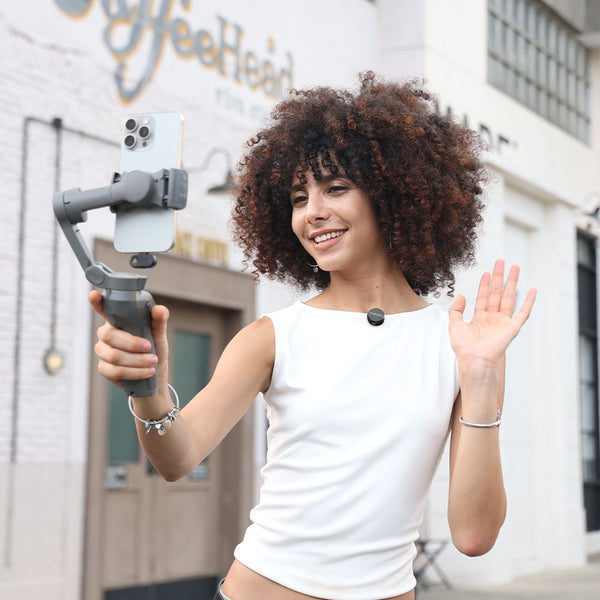Are you a medical expert or a doctor who wants to share advice on how to reduce stress levels? Learn how you can confidently share your expertise across various online platforms using a wireless microphone — whether or not you’re tech-savvy.
There are plenty of plug-and-play wireless mics available, but we highly recommend two of the most versatile, compact, and budget-friendly options: the Maono Wave T5 and the Maono T1 Mini, both featuring noise cancellation. If you’re searching for the best budget wireless mic or need a mic wireless portable enough for on-the-go recordings, these models deliver excellent clarity and convenience. Each comes with a mic and receiver that ensures a stable, interference-free connection—ideal for both professional and beginner users. They’re also considered by many creators as the best budget wireless microphone choices for wellness coaching, presentations, and even as a wireless mic for vlogging. Let’s find out more.
In today’s fast-paced world, stress is one of the most common health challenges people face daily. Whether you’re a healthcare provider, therapist, or wellness coach, sharing practical stress-reduction techniques can make a meaningful difference in others’ lives. But how can you ensure your voice reaches and resonates with your audience—especially in online classes, podcasts, or live workshops?
That’s where a wireless microphone comes in. Using a wireless mic allows you to move freely, maintain consistent audio quality, and create an engaging experience that helps your listeners relax and focus. When your message about stress relief is delivered clearly and calmly, your audience feels safe, heard, and encouraged to follow your guidance.
This article will walk you through effective ways to reduce stress, techniques for speaking calmly using a wireless microphone, and how to set up your mic for relaxation or mindfulness sessions. We’ll also recommend two highly rated and budget-friendly wireless microphones — the Maono Wave T5 and Maono T1 Mini — perfect for professionals and beginners alike.

Things to Do to Reduce Stress Levels
Before discussing how to communicate stress management effectively, it’s important to revisit key habits that genuinely help reduce stress. These are practical, medically recognized techniques anyone can integrate into daily life.
-
Exercise Regularly
Physical activity releases endorphins, the body’s natural mood lifters. Even a 30-minute walk, light jogging, or yoga session can help release tension and improve mental clarity. A 15-minute walk after lunch will also suffice. -
Maintain a Consistent, Healthy Diet
Eating nutrient-rich foods like fruits, vegetables, and whole grains supports brain health and emotional balance. Avoid excessive caffeine or sugar, which can trigger anxiety and energy crashes. -
Quit Smoking and Limit Alcohol
While some use these as coping mechanisms, they actually increase stress levels and disrupt sleep cycles. For true relaxation, it’s best to cut back or eliminate these habits. -
Laugh Often or Watch a Good Movie
Laughter reduces cortisol (the stress hormone) and boosts immune function. A 1-hour comedy movie can be surprisingly therapeutic. -
Connect with Trustworthy People
Talking with supportive friends or family members promotes emotional release and reduces feelings of isolation. Social connection is one of the best natural stress relievers. -
Get Enough Sleep
Lack of rest can worsen irritability, anxiety, and cognitive fatigue. Aim for 7–9 hours of quality sleep each night to rejuvenate your body and mind. -
Practice Breathing Exercises or Yoga
Deep, mindful breathing activates the parasympathetic nervous system, promoting calmness. Yoga combines movement and mindfulness, helping you stay centered. -
Listen to Good Music
Soothing sounds—like instrumental, ambient, or nature-inspired tracks—can help slow your heart rate and reduce stress instantly. -
Try a New Hobby
Activities such as painting, DIY crafting, or gardening stimulate creativity and mindfulness, keeping your focus away from daily worries. -
Seek Counseling or Therapy
Talking to a licensed therapist provides emotional tools and coping strategies for long-term stress management. Professional support helps address underlying causes effectively.
Once you’ve understood these stress management methods, the next step is learning how to communicate them effectively—especially if you’re teaching or sharing them online.
How to Deliver Stress-Relief Tips Confidently Using a Wireless Microphone
Confidence in delivery is key when sharing health or relaxation content. A wireless microphone lets you express naturally and maintain professional sound quality.
Here’s how to use it effectively:
-
Practice Your Script: Rehearse your main points until they sound natural. Avoid reading word-for-word; instead, speak conversationally.
-
Warm Up Your Voice: Simple vocal exercises like humming or lip trills prepare your vocal cords for smooth, consistent tone.
-
Maintain Good Posture: Standing upright improves breathing and projects confidence.
-
Smile While Speaking: Audiences can “hear” a smile—it softens your tone and makes your voice sound friendlier.
-
Use Body Movement: The freedom of a wireless mic allows gentle gestures that emphasize empathy and authenticity.
-
Pause for Effect: Silence can be calming. Allow short pauses between key points to help your audience absorb the message.
When you speak with composure and empathy, your listeners are more likely to feel reassured and relaxed.
Mindful Speaking: Calming Techniques While Using a Wireless Mic
Speaking mindfully is an art. It’s not only what you say but how you say it that shapes the listener’s emotional state. Follow these tips to maintain a soothing and calm presence:
-
Use a Slow, Rhythmic Pace
Avoid rushing. A relaxed tempo mirrors natural breathing patterns and encourages calmness. -
Control Volume and Tone
Speak softly but clearly. A consistent tone is more relaxing than fluctuating highs and lows. -
Breathe Between Phrases
Controlled breathing keeps your voice stable and helps prevent strain. -
Visualize Your Listener
Imagine you’re speaking directly to someone who needs comfort. This adds warmth and sincerity to your delivery. -
Incorporate Gentle Pauses
Brief silences allow listeners to process and reflect—essential in mindfulness or relaxation sessions.
These techniques, combined with the clarity of a wireless mic, enhance the listener’s sense of connection and calm.
Wireless Microphone Setup Tips for Wellness Coaches or Licensed Therapists
A professional setup ensures your stress-relief session sounds clear and distraction-free. Here are setup essentials:
-
Mic Position: Keep your mic 6–8 inches from your mouth to prevent distortion.
-
Check Battery or Charging Level: Always start with a fully charged mic to avoid interruptions.
-
Minimize Background Noise: Record in a quiet space, away from fans, traffic, or electronic hums.
-
Use Pop Filters or Windscreens: These reduce plosive sounds (“p” and “b” noises) and ensure smoother audio.
-
Test Before Going Live: Record a short sample to check clarity, tone, and balance.
-
Use Stable Wireless Connection: Choose a reliable mic system to prevent signal dropouts during long sessions.
These small technical preparations make a huge difference in how professionally your message comes across.
Choosing the Best Wireless Microphone for Relaxation and Health Workshops
When selecting the right wireless mic, focus on sound clarity, comfort, and noise reduction. Here are two excellent options:
-
Maono Wave T5 Wireless Microphone

The Maono Wave T5 is a versatile, portable mic ideal for health coaches, meditation instructors, and doctors who conduct wellness sessions. It features noise cancellation, long battery life, and stable connectivity—ensuring crisp, interference-free sound during classes or therapy talks.
-
Maono T1 Mini Wireless Microphone

Compact and lightweight, the Maono Wave T1 Mini is perfect for beginners or mobile users recording quick stress-relief sessions. It’s a plug-and-play device that connects easily to smartphones or laptops. Despite its size, it delivers professional-grade audio with effective noise suppression.
These microphones both allow you to move freely and speak naturally, helping you maintain a calm, confident presence that your listeners can feel.
FAQs:
1. How can I use a wireless mic to make my stress-relief sessions sound more calming?
Use noise reduction settings, maintain consistent volume, and keep your distance from the mic for balanced, gentle sound.
2. What’s the best microphone technique for delivering relaxation or mindfulness exercises?
Speak slowly and evenly, maintaining a consistent tone. Avoid sudden volume changes.
3. How can I keep my voice tone consistent and soothing during stress-reduction talks?
Hydrate before speaking and take gentle breaths between sentences to prevent tension.
4. What are the medical benefits of listening to calming voice sessions with clear audio?
Clear, soothing audio can lower heart rate, reduce cortisol levels, and promote mental relaxation.
5. How do healthcare professionals use guided breathing and mindfulness over wireless audio?
They use precise pacing and soft vocal guidance to help patients focus on breathing rhythm.
6. What’s the best way to speak slowly and clearly without losing engagement through a mic?
Alternate between explanation and guided action (e.g., “Inhale… now exhale slowly.”).
7. Can using a wireless microphone improve the effectiveness of stress management workshops?
Yes. It allows presenters to move naturally and maintain consistent sound, improving listener focus.
8. What are some vocal warm-ups that help presenters sound relaxed and stress-free?
Humming, gentle lip trills, or slow breathing through the diaphragm for a few minutes.
9. How can I adjust microphone settings to create a calm and noise-free environment?
Lower gain levels slightly and use built-in noise suppression or EQ settings to soften harsh tones.
10. Does audio clarity actually help reduce listener anxiety or tension?
Absolutely. Clear, crisp audio prevents strain and enhances relaxation response.
11. What is the best wireless mic for health coaches giving stress management sessions?
The Maono Wave T5 is excellent for clarity and mobility during workshops.
12. Should I choose a lapel mic or handheld wireless mic for stress-relief classes?
Lapel mics are more discreet and hands-free—ideal for yoga or guided meditations.
13. How do I avoid background noise during relaxation recordings?
Record indoors, close windows, and turn off unnecessary electronics.
14. What are some affordable wireless mics suitable for medical or wellness presentations?
Both Maono Wave T5 and Maono T1 Mini are cost-effective, high-quality choices.
15. How can I set up my wireless mic for online yoga, meditation, or mental health streaming?
Clip your mic near your collarbone, test volume levels, and keep devices fully charged.
16. Are there mic positioning tips that help maintain a soothing sound?
Avoid placing the mic too close—maintain 6–8 inches of distance.
17. Can I connect my wireless microphone directly to my smartphone or laptop for live talks?
Yes. Most modern wireless mics, like Maono models, support plug-and-play connections.
18. What’s the ideal distance from the mouth to achieve a soft yet clear voice tone?
6 to 8 inches works best for clarity and warmth.
19. How can I test my wireless mic setup before delivering medical stress tips live?
Record a 1-minute sample and replay it to check tone, volume, and background noise.
20. Are there specific audio filters or effects that enhance calmness during speech?
Use light compression, low EQ adjustments, and soft reverb for a warm, soothing voice.
Conclusion
Sharing stress-relief advice isn’t just about what you say—it’s about how your voice connects with your audience. A wireless microphone allows you to express empathy and guidance with freedom, confidence, and clarity. Whether you’re a medical expert, wellness coach, or therapist, using tools like the Maono Wave T5 or Maono T1 Mini ensures your sessions sound professional and comforting.
By combining calm delivery, mindful speech, and the right mic setup, you can create a truly healing atmosphere—helping your listeners not only hear your message but feel the peace behind it.
Related Article:
Cortisol & Stress: Effects, Foods, and Wireless Mic Tips for Vlogs



